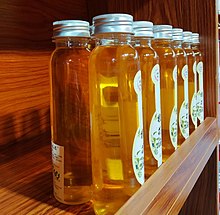| Osmanthus wine | |||||||||
|---|---|---|---|---|---|---|---|---|---|
 Bottles of osmanthus wine | |||||||||
| Chinese | 桂花酒 | ||||||||
| |||||||||
| Alternative Chinese name | |||||||||
| Chinese | 桂酒 | ||||||||
| |||||||||
| Aged osmanthus wine | |||||||||
| Traditional Chinese | 桂花陳酒 | ||||||||
| Simplified Chinese | 桂花陈酒 | ||||||||
| Postal | Kuei Hua Chen Chiew | ||||||||
| Literal meaning | Osmanthus reserve wine | ||||||||
| |||||||||

Osmanthus wine, also known as cassia wine or Kuei Hua Chen Chiew, is a Chinese alcoholic beverage produced from weak baijiu and flavored with sweet osmanthus (Osmanthus fragrans) flowers. It is distilled but typically has an alcohol content less than 20%.
While the plant itself is sometimes associated with cinnamon,[1] the blossoms' lactones impart a flavor closer to apricots and peaches.[2]
Owing to the time at which Osmanthus fragrans flowers, 'cassia' wine is the traditional choice[3][4] for the "reunion wine" drunk during the Mid-Autumn Festival.[5] Because of the homophony between 酒 ("alcohol") and 久 ("long", in the sense of time passing), osmanthus wine is also a traditional gift for birthdays in China.[6] It is also considered a medicinal wine in traditional Chinese medicine.[7] Li Shizhen's Compendium of Materia Medica credits sweet osmanthus with "curing the hundred diseases" and "raising the spirit".[8]
Within China, osmanthus wine is associated with Xi'an[9] and Guizhou,[1][10] but production now occurs throughout China, including Beijing[11] and at the Hong Jiang Winery in Hunan.[12]
References[edit]
- ^ a b Small, Ernest. Top 100 Food Plants, p. 179. NRC Research Press (Ottawa), 2009. Accessed 8 November 2013.
- ^ Chartier, Francois. Taste Buds and Molecules: The Art and Science of Food, Wine, and Flavor, p. 199. John Wiley & Sons (Hoboken), 2012. Accessed 8 November 2013.
- ^ Qiu Yaohong. Origins of Chinese Tea and Wine, p. 121. Asiapac Books (Singapore), 2004. Accessed 7 November 2013.
- ^ Liu Junru. Chinese Food, p. 136. Cambridge Univ. Press (Cambridge), 2011. Accessed 7 November 2013.
- ^ Li Zhengping. Chinese Wine, p. 101. Cambridge University Press (Cambridge), 2011. Accessed 8 November 2013.
- ^ Li Xiaoxiang. Origins of Chinese People and Customs, p. 101. Asiapac Books (Singapore), 2004.
- ^ Flaws, Bob. Chinese Medicinal Wines & Elixers, p. 17. Blue Poppy (Boulder), 1994. ISBN 0936185589. Accessed 8 November 2013.
- ^ "治百病,养精神,和颜色,为诸药先聘通使,久服轻身不老,面生光华,媚好常如童子." – 李时珍 [Li Shizhen]. 《本草纲目》 [Compendium of Materia Medica]. Op. cit. "[1]". Sichuan Online. 22 September 2013. Accessed 8 November 2013.(in Chinese)
- ^ Xiang Yang. Xi'an – China's Ancient Capital, pp. 90 ff. Foreign Languages Press (Beijing), 1993.
- ^ China Directory of Industry and Commerce and Economic Annual, Vol. 2, pp. 429–430. Xinhua Publishing, 1984.
- ^ China Market, Issue 11, p. 15. China Market Publishing Corporation, 1987.
- ^ Zhonghua Mei Jiu, p. 408. 中国轻工业出版社, China. 食品工业局. 轻工业出版社, 1985. Accessed 8 November 2013.
In popular culture[edit]
The beverage is referenced many times in the game Genshin Impact as the favorite beverage of the character Zhongli, the Geo Archon. The wine is also frequently referenced in Chinese period dramas (often referred to as Xianxia or Wuxia).